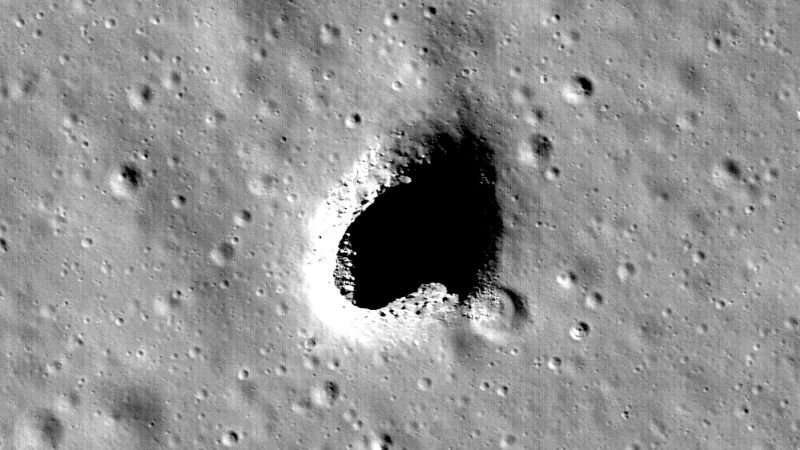The Marius Hills Skylight, as observed by the Japanese SELENE/Kaguya research team. (Image: NASA/Goddard/Arizona State University)
For years, scientists have wondered if dark, crater-like features on the lunar surface might be entrances to giant caverns carved long ago by flowing lava. Researchers from Japan and the United States have uncovered new evidence to prove that these features actually exist—which is good news for future lunar colonists looking for a convenient and safe place to live.
New research published in Geophysical Research Letters shows that several pits located near the Marius Hill region of the Moon are large open lava tubes, and that these ancient caverns have the potential to offer, in the words of the researchers, a “pristine environment to conduct scientific examination of the Moon’s composition and potentially serve as secure shelters for humans and instruments.” The team, which included scientists from NASA and Japan’s space agency, JAXA, combined radar and gravity data to make the finding.
No doubt, these caverns would be perfect for aspiring lunar colonists. Inside these large holes, humans would be protected from the Sun’s dangerous rays, and other hazards. The Moon has no atmosphere to speak of, so these “instant” shelters would be extremely advantageous.
Our future home? A view of the eastern Marius Hills, with the Marius crater at top right. (Image: NASA/Lunar Orbiter 2)
For years, scientists have suspected that these lunar features were lava tubes—naturally occurring channels that form when lava turns into a hard crust. Millions of years ago, when the Moon experienced volcanic activity, flowing lava carved the surface, and when these channels drained, they oftentimes left a hollow void behind. Previous research showed that these caverns, should they exist, would be stable enough for subterranean lunar bases.
JAXA scientists analyzed radar data from the SELENE spacecraft, which was designed to study the origins of the Moon and its geological history. As this new study shows, this instrument is also good for detecting lunar lava tubes, which it does by bouncing radar off the lunar surface. By peppering the entrances to these suspected caverns with radar bursts, the scientists were able to detect a distinctive echo pattern, where a decrease in echo power was followed by a second large echo peak. This pattern was the smoking gun, signifying the presence of a floor and a ceiling of a lava tube. Because the scientists found several similar echo patterns at locations nearby, there may be more than one lava tube.
And it just so happens that this area corresponds to locations where NASA, through its GRAIL mission, was able to identify mass deficits—that is, locations on the lunar surface where mass appears to be reduced or missing, which GRAIL detects as slightly less gravity.
Philadelphia is shown inside a theoretical lunar lava tube. (Image: Purdue University/David Blair)
By combining the SELENE and GRAIL data, the team was able to not just prove the presence of a lava hole, but also the depth and height of the cavity. And it’s big—extending for several kilometers in length, and at least one kilometer in height and width.
Quite suddenly, the Moon seems like a more welcoming place. It’s time for us to go back.

CaptainSk0r on October 19th, 2017 at 15:18 UTC »
It's the hive... their God, crota, lives in the depths of the moon fissures. 6 of us went into that abyss, I was the only one to make it back.
rwhiffen on October 19th, 2017 at 13:43 UTC »
The first comment on the article (currently)
Classic.
iwasnottheone on October 19th, 2017 at 12:34 UTC »
From the article: New research published in Geophysical Research Letters shows that several pits located near the Marius Hill region of the Moon are large open lava tubes, and that these ancient caverns have the potential to offer, in the words of the researchers, a “pristine environment to conduct scientific examination of the Moon’s composition and potentially serve as secure shelters for humans and instruments.” The team, which included scientists from NASA and Japan’s space agency, JAXA, combined radar and gravity data to make the finding.
Edit: From the source article (possibly paywalled):
Intact lunar lava tubes offer a pristine environment to conduct scientific examination of the Moon's composition and potentially serve as secure shelters for humans and instruments. We investigated the SELENE Lunar Radar Sounder (LRS) data at locations close to the Marius Hills Hole (MHH), a skylight potentially leading to an intact lava tube, and found a distinctive echo pattern exhibiting a precipitous decrease in echo power, subsequently followed by a large second echo peak that may be evidence for the existence of a lava tube. The search area was further expanded to 13.00–15.005°N, 301.85–304.01°E around the MHH and similar LRS echo patterns were observed at several locations. Most of the locations are in regions of underground mass deficit suggested by GRAIL gravity data analysis. Some of the observed echo patterns are along rille A, where the MHH was discovered, or on the southwest underground extension of the rille. http://onlinelibrary.wiley.com/doi/10.1002/2017GL074998/full
Also posted on Slashdot, 3:00 pm EST, The Guardian article: https://science.slashdot.org/story/17/10/19/1758206/discovery-of-50km-cave-raises-hopes-for-human-colonisation-of-moon#comments